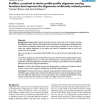148 search results - page 21 / 30 » The evolutionary capacity of protein structures |
BMCBI
2005
13 years 7 months ago
2005
Background: Profile-profile methods have been used for some years now to detect and align homologous proteins. The best such methods use information from the background distributi...
RECOMB
2003
Springer
14 years 7 months ago
2003
Springer
Protein sequence alignments are more reliable the shorter the evolutionary distance. Here, we align distantly related proteins using many closely spaced intermediate sequences as ...
TFS
2008
13 years 7 months ago
2008
Abstract--This study proposes an efficient self-evolving evolutionary learning algorithm (SEELA) for neurofuzzy inference systems (NFISs). The major feature of the proposed SEELA i...
BMCBI
2005
13 years 7 months ago
2005
Background: Probabilistic models for sequence comparison (such as hidden Markov models and pair hidden Markov models for proteins and mRNAs, or their context-free grammar counterp...
BMCBI
2006
13 years 7 months ago
2006
Background: Many biological processes involve the physical interaction between protein domains. Understanding these functional associations requires knowledge of the molecular str...

